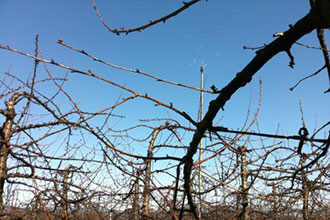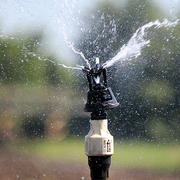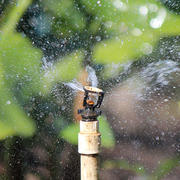
Irrigation systems are vital for crop germination and are frequently used to distribute fertilizers or chemicals. In colder climates, overhead systems are also used for frost protection.
Both drip and overhead systems can be used for fertigation or chemigation. However, drip can limit the options when it comes to product selection.
Growers can use foliar or soil-applied fertilizers with sprinklers. Foliar fertilizers are ideal for correcting nutrient deficiencies and reducing postharvest disorders. Foliar products take advantage of the leaves’ effectiveness in transporting nutrients.
Certain soil conditions, such as high pH, low pH, drought, excessive moisture or cool temperatures, can make nutrient uptake through roots difficult. This means soil-applied fertilizers can keep crops healthy if the pH isn’t limiting nutrient availability.
Overhead systems also provide better pesticide options. With sprinklers, growers can throw chemicals on the underside of leaves, where insects and their eggs may hide. This helps prevent plant diseases and fungal problems caused by common pests.
When it comes to germination, overhead sprinklers apply water over the entire soil surface in a pattern similar to rainfall. The rain-like pattern makes sprinklers suitable for germination and irrigation, which is why sprinklers are used throughout the growing season. Drip systems place water near the drip line and are not as effective at germinating small seeds. This is especially true for sandy soils, since water may not be able to disperse horizontally and encourage root expansion.
Many growers with drip systems rely on other means of wetting the soil before they attempt germination. Nature doesn’t always cooperate, so growers may use overhead systems to imitate rainfall. If they decide to continue with drip for germination, they must pay attention to soil preparation, drip tape placement, and irrigation scheduling.
Perhaps the biggest benefit of overhead systems is their ability to protect crops from frost damage in cold climates.
Sprinklers can protect crops from frost damage if evaporation is low but dew points are high in climates where temperatures drop to around 32 degrees Fahrenheit. They spray a consistent, uniform layer of water that freezes and crystallizes over plants. The freezing process releases about 80 calories of heat for every 0.03 ounce of water that freezes. The ice encases the plant and partially isolates it from the harsh temperatures.
Plus, sprinklers are more economical than heaters, with some sprinklers generating 2.5 million kilocalories of heat per hectare per hour with only 5 kilowatts of electric power.



